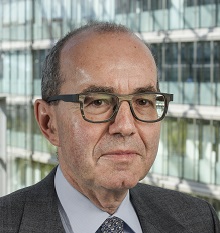I recently participated in Chatham House Webinar: Creating a New Generation of Antibiotics. It was a great opportunity for me to tell Jim O’ Neill, how little over a year ago, he played a role in speeding up industry action on AMR – something I had decided the IFPMA should engage on when I took up as DG of the association representing the biopharmaceutical industry globally. He called on the biopharmaceutical industry to step up and play a role in helping fend off the potentially staggering cost of AMR and the frightening impact it would have on health and our economies. He struck a chord, and it led to the creation about a year later of the AMR Action Fund, which was launched this July.
The world needs a new generation of antibiotics to address the rapid growth in antibiotic-resistant bacteria. The UK government’s 2014 Review on Antimicrobial Resistance estimated that such bacteria could result in the deaths of 10 million people a year by 2050 and an accumulated cost of up to $100 trillion to the global economy. Despite this urgent need, there remain few new antibiotics in development due to a lack of commercial viability for pharmaceutical companies with a 2019 Chatham House report highlighting the lack of progress being made on critical recommendations to tackle antimicrobial resistance.
I joined the Chatham House Webinar: Creating a New Generation of Antibiotics on 22nd September to add the industry’s perspective on this difficult dilemma. I shared the panel with:
- Jim O’Neill, Chair, Chatham House
- Kevin Outterson, Associate Fellow, Global Health Programme, Chatham House; Executive Director, CARB-X; Professor, Boston University
- Laura Piddock, Director of Scientific Affairs, Global Antibiotic Research and Development Partnership
We discussed the urgency of the development of new antibiotics and recent efforts to address the funding gap. COVID-19 was the unknown pandemic, the ‘Disease X’ predicted by experts, but not prepared for. On the other hand, AMR was predicted by Alexander Fleming in 1945 and experts track increasing resistance in the most dangerous bacteria, year on year. We knew from Jim O’Neill’s 2014 report and others, of the staggering cost of AMR and the frightening impact it would have on health and our economies.
Sadly, six years down the line from O’Neill’s recommendations, we saw that nothing much had happened.
Moreover, industry was being blamed because more and more companies were getting out of the antibiotics space. A number of biotech companies focussed on antibiotic research have gone bankrupt, or are struggling to raise funding. All of this is because there is no market for antibiotics: often times it costs more money for them to stay in the market than to cut their losses on research and development costs.
So the industry decided to make the first move and signed a check of 1 billion dollars to help develop novel antibiotics.
I have to say, we were concerned when we were ready to go public on the AMR Action Fund that it would be drowned in COVID-19. However, we were pleasantly surprised because politicians and the media reacted well – they were interested and did appreciate the need to take action on AMR. We got a positive response from across the AMR and public health world as well as from politicians, who were encouraged to see that industry was willing to invest in something where there was no money to be made but where there was a huge public health problem.
The commitment was evident at the launch of the AMR Action Fund in Berlin where two health ministers took time out from overseeing their respective country’s response to COVID-19 to acknowledge the importance of tackling AMR. The German Minister of Health, Jens Spahn said, “If states, business and science join forces, we will make a difference … And that is encouraging for this new fund and the initiatives around AMR.” He went on to reassure all stakeholders present that: “Antimicrobial resistance will get the attention it needs during the EU German Council presidency.”
Raising a billion dollars, we believe is more than moving the needle, it is potentially a game changer.
If you look at the statistics on antibiotic research, about two thirds to 80% of the R&D is invested from the private sector, but by and large by just four or five companies. Therefore, being able to raise money from 23 research based pharmaceutical companies from outside of the antibiotic business, was quite an achievement.
The Fund is unique in that it will invest where there is more need and where it has a higher chance of success. Thanks to the work of CARB X and others, there is more interest in early research and discovery research, but after that there is a “valley of death”. Therefore, the focus of the Fund is on clinical development in the early development stage.
The second element which is crucial is that this is not to make money. The strategy is driven by the WHO priority list of pathogens and CDC priorities. Therefore, clearly driven by public health considerations and not return on investment.
The third important element is that the private sector has been the first mover and now we need support from all the stakeholders to drive the debate about policy change.
We all agree this would be a drop in the ocean if we fail to instigate policy reform to make antibiotic research something exciting, but also sustainable and viable.
The AMR Action Fund will make sure that the money is well invested, and that science and public health are the main considerations.
Watch the full interview here









